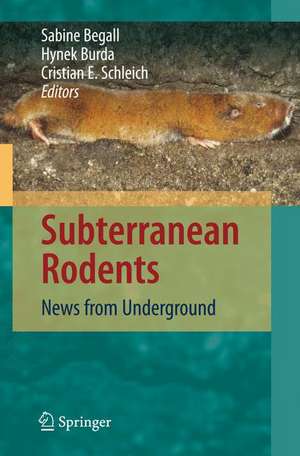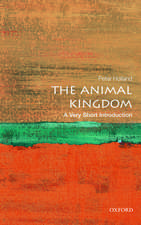Subterranean Rodents: News from Underground
Editat de Sabine Begall, Hynek Burda, Cristian Eric Schleichen Limba Engleză Hardback – 2 mai 2007
| Toate formatele și edițiile | Preț | Express |
|---|---|---|
| Paperback (1) | 1046.51 lei 38-44 zile | |
| Springer Berlin, Heidelberg – 14 oct 2010 | 1046.51 lei 38-44 zile | |
| Hardback (1) | 1231.01 lei 6-8 săpt. | |
| Springer Berlin, Heidelberg – 2 mai 2007 | 1231.01 lei 6-8 săpt. |
Preț: 1231.01 lei
Preț vechi: 1501.23 lei
-18% Nou
Puncte Express: 1847
Preț estimativ în valută:
235.63€ • 256.03$ • 198.06£
235.63€ • 256.03$ • 198.06£
Carte tipărită la comandă
Livrare economică 21 aprilie-05 mai
Preluare comenzi: 021 569.72.76
Specificații
ISBN-13: 9783540692751
ISBN-10: 3540692754
Pagini: 416
Ilustrații: XVIII, 398 p.
Dimensiuni: 155 x 235 x 32 mm
Greutate: 0.83 kg
Ediția:2007
Editura: Springer Berlin, Heidelberg
Colecția Springer
Locul publicării:Berlin, Heidelberg, Germany
ISBN-10: 3540692754
Pagini: 416
Ilustrații: XVIII, 398 p.
Dimensiuni: 155 x 235 x 32 mm
Greutate: 0.83 kg
Ediția:2007
Editura: Springer Berlin, Heidelberg
Colecția Springer
Locul publicării:Berlin, Heidelberg, Germany
Public țintă
ResearchDescriere
Across the globe, about 250 species of rodents spend most of their lives in safe and stable, but dark, oxygen-poor and carbon dioxide-rich burrows, deprived of most of the sensory cues available aboveground. They have become fully specialized for a unique way of life in which foraging and breeding take place underground. The systematic research into adaptations of subterranean dwellers is only about two decades old, but it has rapidly intensified within the last few years, bringing insight into many aspects of the biology and evolution at different organization levels.
Subterranean Rodents presents achievements from the last years of research on these rodents, divided into five sections: ecophysiology; sensory ecology; life histories, behavioural ecology and demography; environmental and economical impact; molecular ecology and evolution. It is a must for all researchers working in this field and will be of interest to zoologists, physiologists, morphologists, ecologists, and evolutionary biologists.
Subterranean Rodents presents achievements from the last years of research on these rodents, divided into five sections: ecophysiology; sensory ecology; life histories, behavioural ecology and demography; environmental and economical impact; molecular ecology and evolution. It is a must for all researchers working in this field and will be of interest to zoologists, physiologists, morphologists, ecologists, and evolutionary biologists.
Cuprins
Subterranean Rodents: News from Underground.- Ecophysiology.- Adaptive Physiological Mechanisms in the Underground Dwellers.- Microclimate in Burrows of Subterranean Rodents — Revisited.- New Data on Metabolic Parameters in Subterranean Rodents.- Skimping as an Adaptive Strategy in Social Fossorial Rodents: The Mole Vole (Ellobius talpinus) as an Example.- The Reproductive Physiology and Endocrinology of the African Mole-rats: with Special Reference to Southern African Mole-rat Species.- Sensory Ecology.- Sensory Ecology of Subterranean Rodents.- Using Odors Underground.- Acoustics, Audition and Auditory System.- Acoustic Communication in Subterranean Rodents.- Visual Systems and the Role of Vision in Subterranean Rodents: Diversity of Retinal Properties and Visual System Designs.- Magnetic Compass: A Useful Tool Underground.- Adaptive Neural Organization of Naked Mole-Rat Somatosensation (and Those Similarly Challenged).- Life Histories, Behavioural Ecology, Demography.- From Natural Histories to Life Histories — A Homage to a Comparative Approach.- Giant Mole-rats, Fukomys mechowii, 13 Years on the Stage.- Biology of the Silvery Mole-rat (Heliophobius argenteocinereus). Why Study a Neglected Subterranean Rodent Species?.- The Biology and Ecology of Plateau Zokors (Eospalax fontanierii).- Senescence Patterns in African Mole-rats (Bathyergidae, Rodentia).- Environmental and Economic Aspects.- The Influence of Subterranean Rodents on the Environment.- The Influence of Pocket Gophers on the Biotic and Abiotic Environment.- Subterranean Rodents as Pests: The Case of the Pocket Gopher.- Influence of Plateau Zokors (Eospalax fontanierii) on Alpine Meadows.- Mountain Beaver: A Primitive Fossorial Rodent.- Molecular Ecology and Evolution.- Molecular Ecology and Evolution.- The Multiple Meanings of Inbreeding: The Key to Understanding the Social and Genetic Structure of Subterranean Rodent Populations.- Behavior, Demography, and Immunogenetic Variation: New Insights from Subterranean Rodents.- African Mole-rats (Bathyergidae): A Complex Radiation in Tropical Soils.- Mosaic Evolution of Subterranean Mammals: Tinkering, Regression, Progression, and Global Convergence.
Recenzii
From the reviews:
“This book is the result of a symposium entitled ‘Light from the underground: Challenges and insights in the third decade of research on subterranean rodents,’ held during the International Mammalogical Congress IX in Sapporo … . provides a set of important tidbits, factoids, pieces of general information, and current hypotheses relevant to the topic at hand. … Given the broad nature of topics included, the book is a one-stop shopping place for a plethora of knowledge concerning the biology of subterranean rodents.” (Robert D. Bradley, Journal of Mammalian Evolution, Vol. 17, March, 2010)
“This book is the result of a symposium entitled ‘Light from the underground: Challenges and insights in the third decade of research on subterranean rodents,’ held during the International Mammalogical Congress IX in Sapporo … . provides a set of important tidbits, factoids, pieces of general information, and current hypotheses relevant to the topic at hand. … Given the broad nature of topics included, the book is a one-stop shopping place for a plethora of knowledge concerning the biology of subterranean rodents.” (Robert D. Bradley, Journal of Mammalian Evolution, Vol. 17, March, 2010)
Caracteristici
Presents a comprehensive treatment of the biology, ecology and evolution of subterranean mammals
Forty authors, authorities in their field, from 12 different countries have contributed to the book
Short introductions into each key field are provided
Includes supplementary material: sn.pub/extras
Forty authors, authorities in their field, from 12 different countries have contributed to the book
Short introductions into each key field are provided
Includes supplementary material: sn.pub/extras













